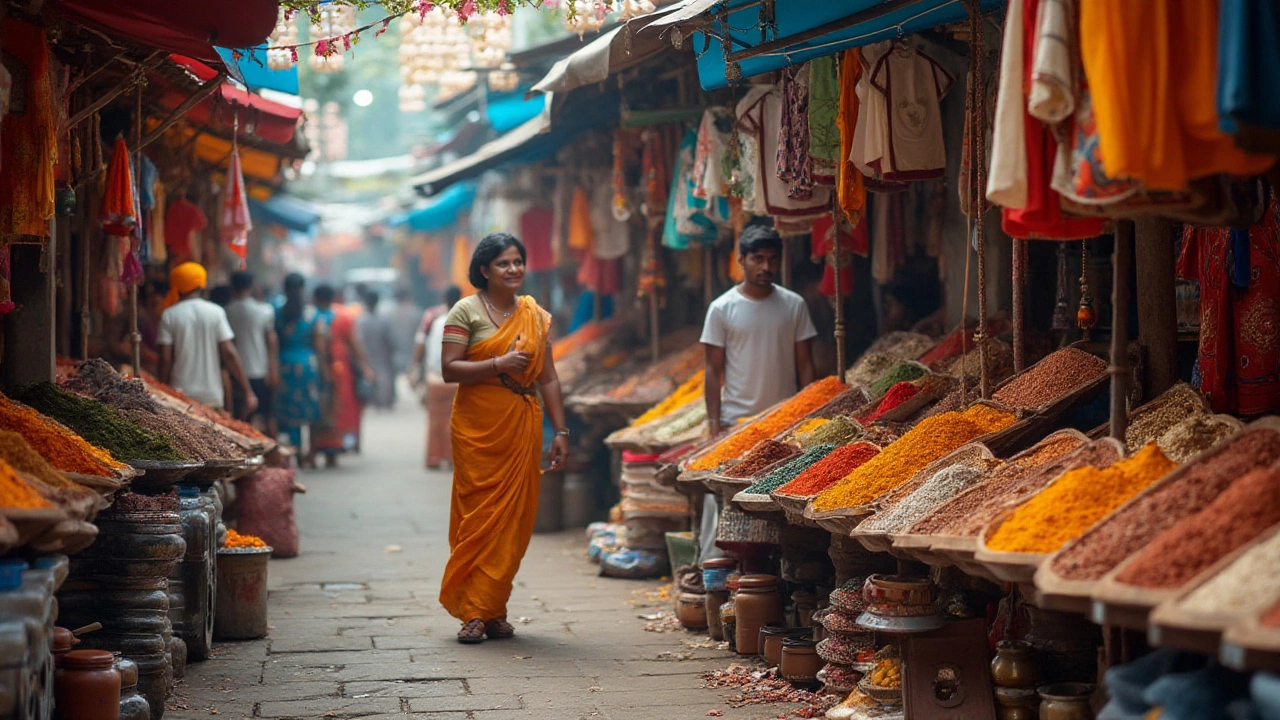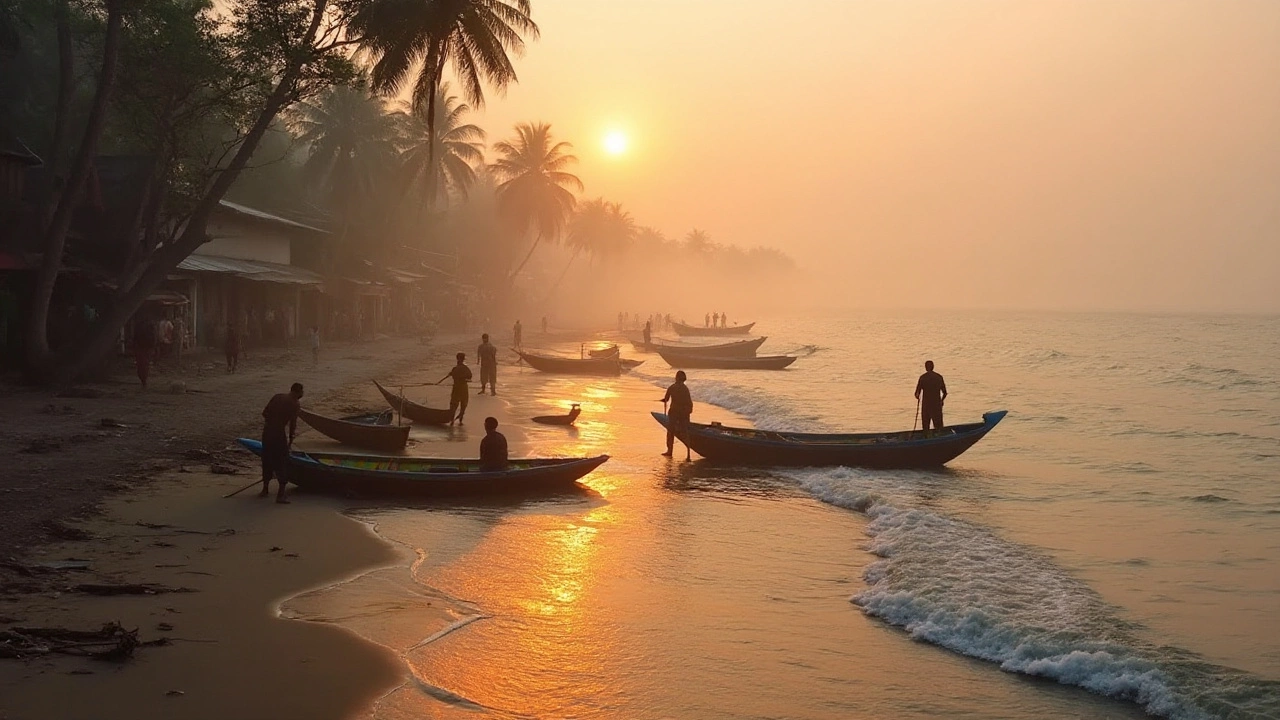Imagine stepping into a land of spice-laden air, vibrant festivals, and landscapes that shift from golden beaches to rolling tea plantations. South India calls out with its promise of adventure, culture, and beauty. But when is the most budget-friendly time to answer this call? For those with an adventurous spirit, finding the perfect moment that marries cost and experience is crucial.
Understanding the fluctuations of travel costs throughout the year can help you make informed decisions. India, vast and diverse, offers a myriad of experiences, each season cloaking the land in different wonders. Here's a look into making your South Indian dream trip wallet-friendly without missing out on the magic.
- Understanding India's Seasonal Patterns
- Advantages of Traveling Off-Peak
- Budget-Friendly Destinations in South India
- Tips for Saving Money While Traveling
- Cultural Experiences on a Budget
Understanding India's Seasonal Patterns
South India, known for its stunning diversity from the beaches of Goa to the lush landscapes of Kerala, experiences a wide range of seasonal variations that significantly affect travel plans. The region predominantly enjoys three seasons: summer, monsoon, and winter. Each of these seasons creates a distinct atmosphere, both literally and in terms of travel experiences. For those looking to explore India travel opportunities, understanding these seasonal shifts is key to finding the best time for budget-friendly adventures.
The summer months, typically from March to May, bring soaring temperatures that often exceed 35°C. This is the hottest period, making coastal areas like Tamil Nadu and Andhra Pradesh feel like a furnace. Tourists often avoid South India during these months due to the harsh heat. However, for the cost-conscious traveler willing to brave the sun, this is a time when accommodation and flight prices drop significantly. Off-peak travel during these months can offer an affordable way to explore the beautiful hill stations such as Ooty and Coorg, where the temperatures remain relatively cooler.
The arrival of the monsoon around June introduces dramatic changes to the landscape. From June to September, the southwest monsoon brings heavy rains, transforming the scenery into a lush, green paradise. While the downpour might deter some travelers, the season offers its unique charm with waterfalls at full capacity and vibrant festivals like Onam in Kerala. Off-peak travel during the monsoon can be a budget-friendly option for those who appreciate nature's grandeur, daring a few showers for discounted rates and fewer tourists. In fact, a seasoned traveler once said, "Embracing the monsoon in South India is like witnessing nature in its most unfiltered form."
Winter, spanning from October to February, is undoubtedly the most appealing time to visit South India. The weather becomes pleasant with temperatures hovering between 20-25°C, offering ideal conditions for exploring historical sites such as Hampi and discovering culinary delights in the bustling markets of Chennai. This climate attracts tourists from around the globe, making it the peak travel season with corresponding higher prices for flights and accommodations. But planning well in advance or seeking out lesser-known destinations can still offer some savings during this time. A table highlighting average monthly temperatures and rainfall for key destinations can prove useful for planning:
| Month | Temperature (°C) | Rainfall (mm) |
|---|---|---|
| January | 23 | 17 |
| July | 28 | 136 |
| November | 25 | 70 |
By understanding South India's seasonal patterns, travelers can make informed choices about the best times to visit, aligning their desires for cost savings with the experiences they hope to gain. Whether it's experiencing the cultural vibrancy of festivals during the monsoon or relishing the cooler temperatures of winter, India's seasons offer something special for everyone.
Advantages of Traveling Off-Peak
Traveling during the off-peak season might not be everyone's first choice, but those who do discover a treasure trove of benefits that often go unnoticed. Imagine wandering through the magnificent temples of South India, such as the Brihadeeswara Temple in Tamil Nadu, without the pressing crowd clamoring for a perfect photo. When you choose to explore during off-peak times, you essentially step into a more intimate and personal travel experience. You'll have the opportunity to delve deeper into the local culture, engaging more meaningfully with the residents who aren't overwhelmed by the tourist rush. The ability to connect with the people and the place on a more profound level is one of the understated joys of traveling during less busy times.
Another significant advantage lies in the cost savings, a key consideration for budget travelers eager to explore India. Flights are significantly cheaper when there isn't a mad scramble for seats, and accommodation rates drop substantially. You could find yourself staying in some of the charming heritage hotels for a fraction of the price during the bustling tourist season. It isn't just flights and lodging where you save; many attractions reduce their entry fees during off-peak months. Take advantage of these lower costs and channel your savings into enriching your trip with a more luxurious dining experience or an additional guided tour that you might have skipped otherwise.
The off-peak season in South India often coincides with the monsoon, painting the lands in lush greens and filling the rivers and backwaters to the brim. While some might view the rain as a deterrent, for the avid traveler, it unveils a new aspect of beauty unique to this time of year. The monsoon season, though a bit unpredictable, offers a chance to witness the dramatic transformation of landscapes. With a sturdy umbrella in tow and flexible plans, this time becomes one of exploration and unexpected discoveries. Accommodations tend to be less crowded, and service becomes a tad more personalized, making it seem like Southern India is unveiling itself to you alone.
Not to forget, traveling off-peak gives you the luxury of exploring at your own pace. Renowned tourist hotspots like the backwaters of Kerala or the bustling cityscape of Bangalore are lovely to visit when they aren't filled to the brim with tourists. You'll find photography opportunities are much better, with the freedom to linger and capture those moments to your heart's desire. Restaurants, markets, and popular cafes are more accessible, letting you truly savor the flavors of local cuisine without the pressure of the clock. As a traveler during this time, you're not just experiencing the place; you're living it.
Lonely Planet remarks, "Travel off-season, and you'll discover a world less traveled and memories that last forever, sometimes at half the cost." This quote illuminates the essence of off-peak travel, encapsulating the magic of experiencing known destinations in a whole new light. Whether it’s discovering a quaint village you might otherwise have skipped or having an unexpectedly profound cultural exchange, the off-peak season rewards you with stories and experiences exclusive to those who dare to venture beyond the norm.

Budget-Friendly Destinations in South India
South India is a treasure trove for travelers seeking delightful experiences without burning a hole in their pocket. Tucked away beyond the world of pricey resorts and luxurious stays, it offers a wealth of budget travel options that promise rich cultural immersion and breathtaking scenery. One such gem is the enchanting state of Kerala, often called 'God's Own Country'. With its sun-kissed beaches, serene backwaters, and lush green hills, Kerala is a spectacle to behold, offering travelers an array of affordable accommodations ranging from quaint homestays to charming houseboats. Not to mention, the local cuisine, laden with coconut-infused flavors, is as delicious as it is budget-friendly.
Moving to the vibrant state of Tamil Nadu, the city of Madurai is a must-visit. Known for the architecturally stunning Meenakshi Amman Temple, this city offers a slice of historical and cultural delights without high expenditure. Street markets brim with traditional handicrafts and textiles, providing affordable mementoes of your journey. With an efficient public transport system, exploring the hidden corners of this history-rich city becomes an economical yet enriching experience for India travel enthusiasts.
Then there's the city of Mysore in Karnataka, renowned for its majestic Mysore Palace and vibrant festivals. It welcomes travelers with open arms, offering a variety of attractions that can be enjoyed with minimal spending. The Devaraja Market is a delightful spectacle of colors and aromas, where you can sample local produce and purchase exotic spices at bargain prices. Travelers keen on experiencing South India on a budget would find Mysore's array of cost-effective lodging options and straightforward travel logistics truly beneficial.
Hidden Gems for the Curious
For those who heed the call of the sea, Rameswaram is an idyllic coastal town offering a tranquil retreat. Its pristine beaches are perfect for unwinding, while the Ramanathaswamy Temple adds a spiritual dimension to your journey. History buffs should consider venturing to Hampi, an ancient village dotted with ruins of the Vijayanagara Empire. The surreal landscape here, coupled with its architectural splendor, offers a unique allure at a remarkably low cost.
"South India is a paradise that offers countless delights for the budget-conscious traveler," says travel expert Lara Wilkinson.
Whether it’s soaking in the spiritual aura of its ancient temples or exploring its lush national parks teeming with wildlife, South India's destinations promise a captivating travel experience that is as kind to your wallet as it is enriching for your soul.
| Destination | Main Attractions | Approximate Cost Per Day (USD) |
|---|---|---|
| Kerala | Beaches, Backwaters, Hill Stations | 30-50 |
| Madurai | Meenakshi Temple, Street Markets | 25-40 |
| Mysore | Mysore Palace, Markets | 20-35 |
| Rameswaram | Beaches, Ramanathaswamy Temple | 25-30 |
Tips for Saving Money While Traveling
Traveling to South India on a budget isn't just a dream. With some practical strategies, you can make it quite affordable without sacrificing the experience. The very first thing you might want to do is consider traveling during the monsoon months, primarily between June and September. During this time, tourists are fewer, and you can usually snag deals on accommodations and flights. Don't worry too much about the rain within this period. The showers are often brief and can bring a refreshing vibe to the lush landscapes.
Where you lay your head at night makes a big difference in the cost. Switch out costly hotels for local homestays and hostels. Not only do they offer a feel of authentic living, but they can also significantly cut down accommodation expenses. You can also use platforms like Airbnb that might have cheaper options compared to traditional hotels. Traveling by train or bus is another artery to saving money. Indian Railways covers a broad network at economical rates, adding a slice of adventure to your travel plans. Opting for sleeper classes can slash costs further, providing not just a ride but a glimpse into the local way of life.
Food is another area where mindful choices can create savings. Eating like a local often proves delightful to your palette and pocketbook. Traditional eateries or 'dhabas' serve delicious dishes at a fraction of the price you'd find in tourist hotspots. Vegetarian meals are more common, delicious, and budget-friendly due to lower production costs. For those hesitant about street food, choosing vendors busy with locals can assure freshness and safety.
According to the World Food Travel Association, a whopping 93% of travelers engage in unique food experiences, which can be enjoyed economically.
When it comes to sightseeing, many temples, natural parks, and beaches in South India require no entry fees. But for those that do, consider city passes that offer discounts at major locations and streamline entry procedures. Bargaining is part and parcel of shopping in India. Don't shy away from haggling at local markets where you can discover the region's crafts and produce at low prices. Being polite yet assertive works wonders.
Finally, technology can be a great ally in sticking to your budget. With a plethora of travel apps, you can compare price points for everything, from local transport to meals in real time. Apps like Rome2Rio can help track the best value routes, while Skyscanner keeps an eye on flight deal fluctuations. It's wise to set fare alerts in advance for significant savings. Traveling with cash is another excellent tip, as ATMs might charge hefty fees for withdrawals, and currency exchange counters often impose a steep premium.
Crafting a budget-friendly journey to South India isn't just a possibility; it's an enriching experience that immerses you fully in the local culture while saving your hard-earned cash. Pack light, travel smart, and let each rupee take you further along Tamil Nadu's coastlines or Kerala's backwaters.

Cultural Experiences on a Budget
Traveling through South India on a budget doesn't mean you have to compromise on the rich cultural experiences this region offers. In fact, some of the most deeply immersive experiences can be delightfully economical. Whether it's exploring ancient temples or enjoying regional festivals, South India is a paradise for the culturally curious. The temples of Tamil Nadu, for instance, are not just places of worship but architectural marvels. The intricate carvings, the towering gopurams, and the vibrant frescoes offer a journey through history. Many of these temples, such as the Brihadeeswarar Temple in Thanjavur, are UNESCO World Heritage Sites and don't have an entry fee, inviting you to step back in time freely and ponder over stories etched in stone.
Attending festivals is another cost-effective way to intimately experience the local culture. South India is famous for its lively festivals, and the Pongal festival in January celebrates the harvest season with much fervor. It is a multi-day event filled with music, dance, and an array of traditional South Indian delicacies. The best part? You often needn't spend anything to enjoy the splendor since many communities welcome outsiders with open arms. As a traveler, you’re bound to be invited to participate, offering a unique glimpse into the joyous local customs. According to a local saying, "India's culture cannot be experienced; it can only be lived."
"Travel makes one modest. You see what a tiny place you occupy in the world." - Gustave Flaubert
The bustling bazaars of South India also present an opportunity to soak in the cultural fabric without spending excessively. Whether it’s the aromatic spice markets of Kerala or the vibrant textile bazaars in Andhra Pradesh, every marketplace is alive with the chatter of locals and the melodic haggling of vendors. Sampling street food in these markets, like the crispy dosa or spicy Andhra biryani, can also be a gastronomic delight for just a few rupees. Adventure awaits as you dive into this cacophony of colors and sounds, where every item tells a story, and every vendor has a tale to tell.
For those more inclined towards the arts, South Indian classical dance performances can be a mesmerizing experience. The Bharatnatyam dance form is famous worldwide, and local dance schools often host shows that are affordable, if not free. These dance forms, with their flowing movements and expressive storytelling, offer an enchanting look at the region’s artistic heritage. Such performances are not just shows but encapsulations of mythology set to music, beckoning you to feel the rhythm in your bones. If you’re fortunate, you might even find impromptu street performances, where you can linger and appreciate the artistry at no cost.
Another enchanting yet budget-friendly cultural activity is exploring the landscapes that South India is known for. Walking tours through heritage towns like Hampi or the French-influenced architecture of Pondicherry offer rich explorations at minimal costs. These places are ripe with remnants of colonial history, each street whispering tales of times past. Visitors can spend hours strolling through these streets, absorbing not just the beauty of the local architecture but also engaging with the ©harmony of cultures that have settled here over centuries. Such explorations reflect the soul of India—diverse and timeless, each corner offering a new chapter in its long history, all waiting to be discovered by the curious traveler.
